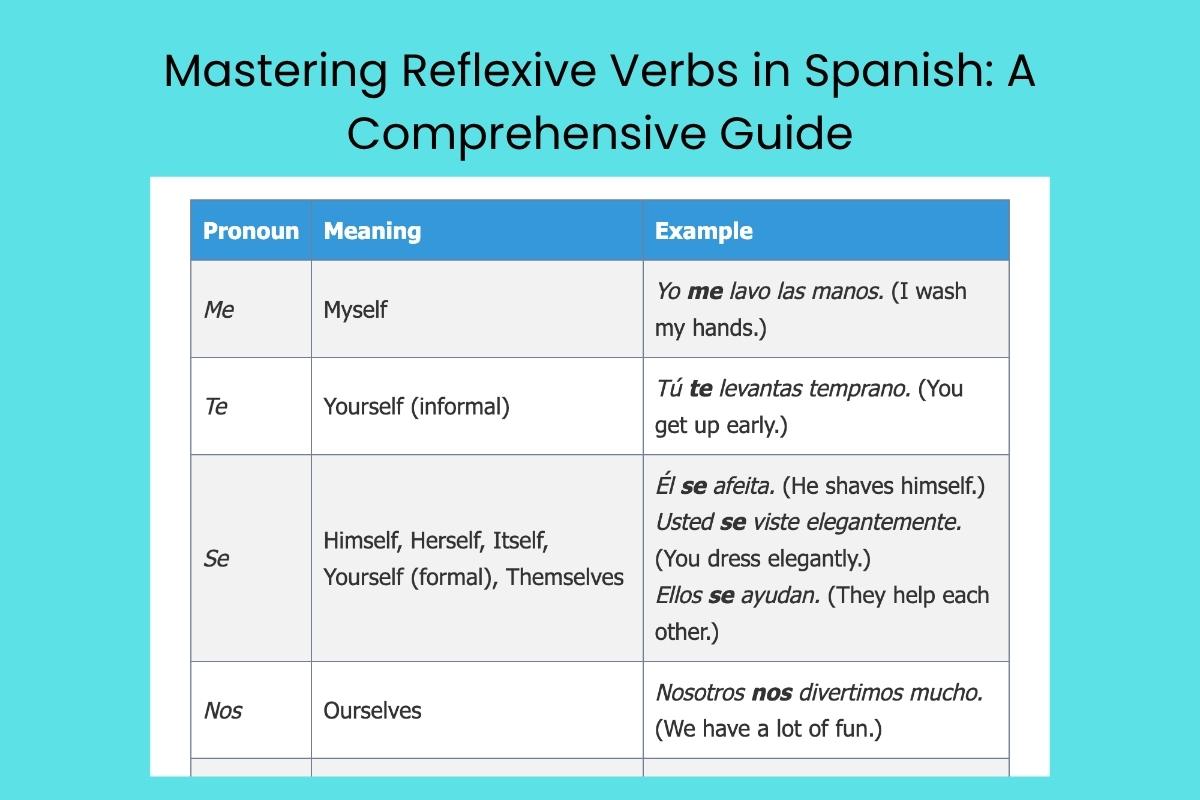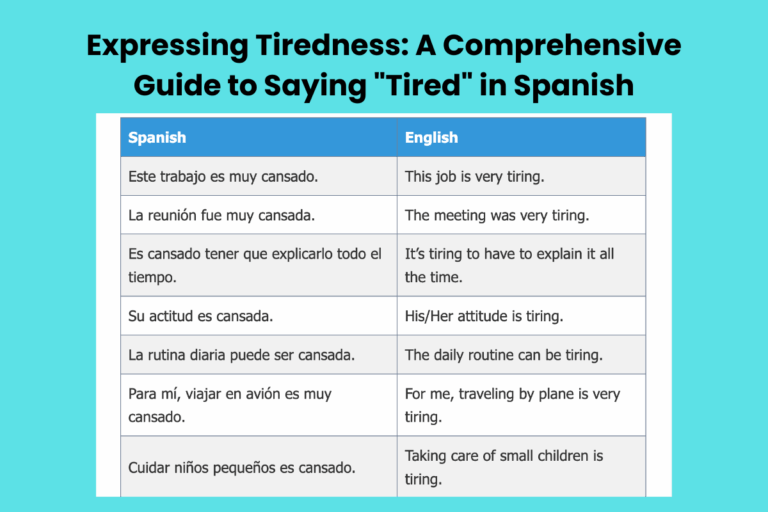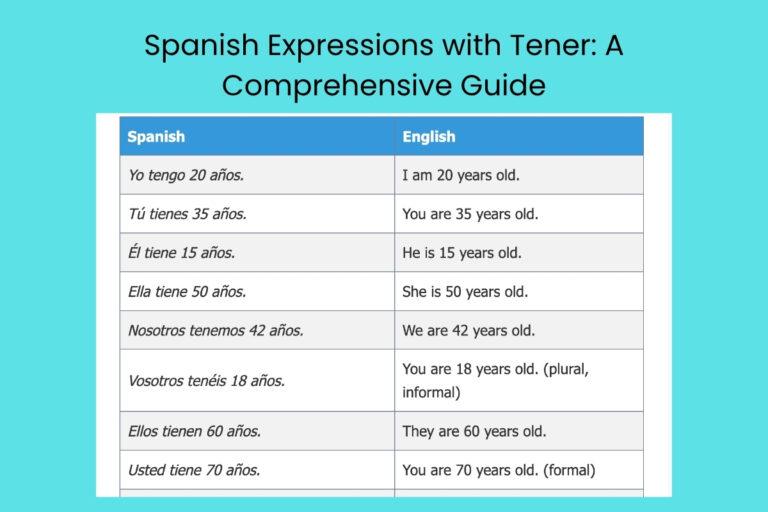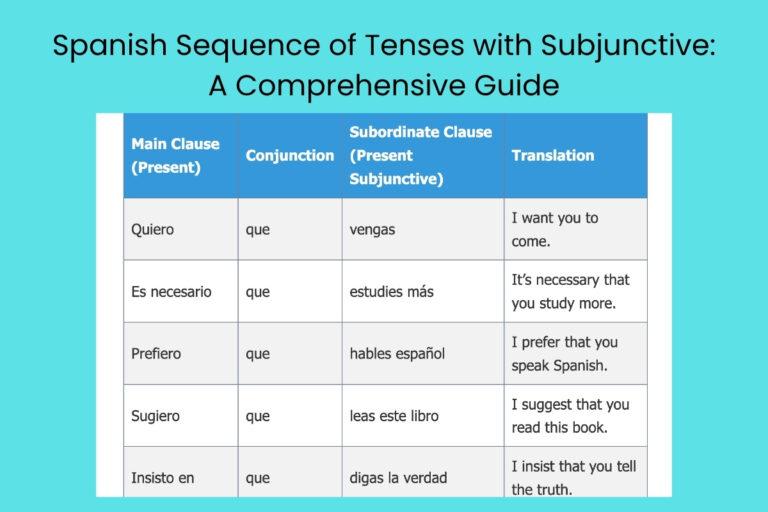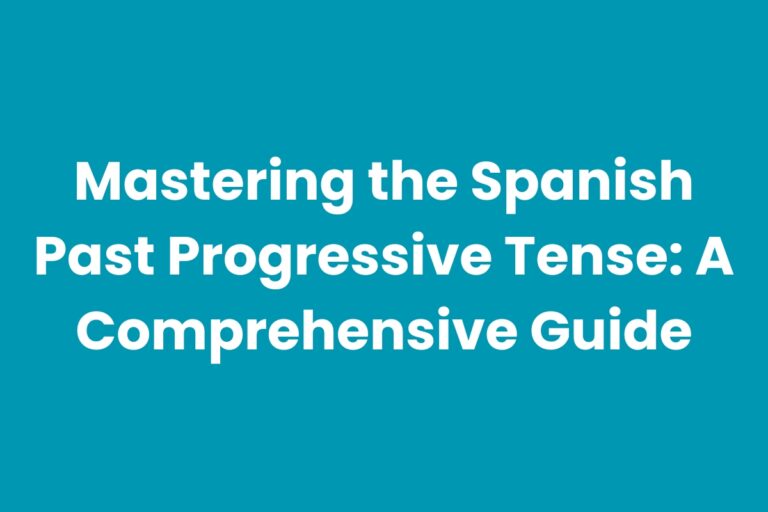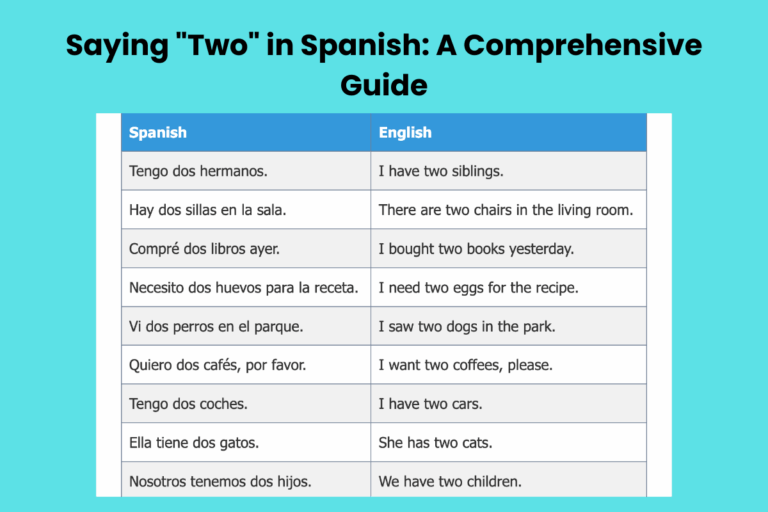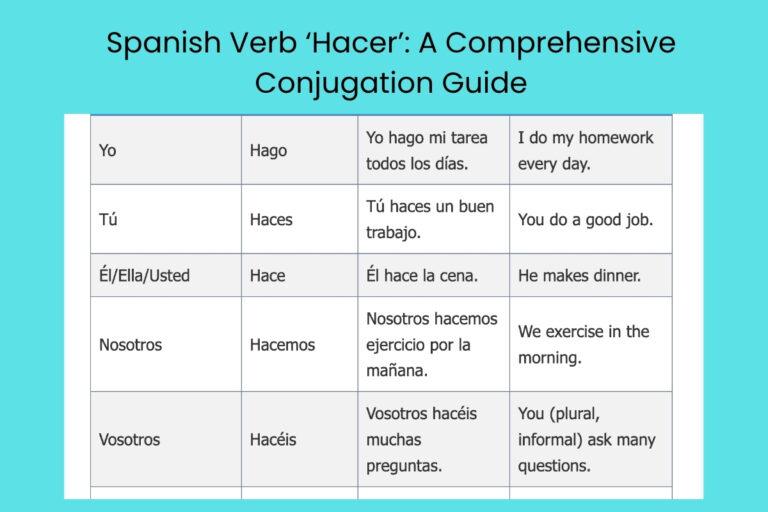Mastering Reflexive Verbs in Spanish: A Comprehensive Guide
Reflexive verbs are a fascinating and essential aspect of Spanish grammar. They add depth and nuance to how actions are expressed, particularly when the subject and object of the verb are the same.
Understanding reflexive verbs is crucial for achieving fluency and accurately conveying your intended meaning. This guide is designed to provide a comprehensive overview of reflexive verbs, covering their definition, structure, usage rules, and common mistakes.
Whether you’re a beginner or an advanced learner, this article will equip you with the knowledge and practice you need to master this important grammatical concept.
Table of Contents
- Definition of Reflexive Verbs
- Structural Breakdown
- Types and Categories of Reflexive Verbs
- Examples of Reflexive Verbs
- Usage Rules
- Common Mistakes
- Practice Exercises
- Advanced Topics
- FAQ
- Conclusion
Definition of Reflexive Verbs
Reflexive verbs in Spanish are verbs where the action performed by the subject is also received by the subject. In simpler terms, the subject and the object of the verb are the same person or thing.
This contrasts with regular verbs where the action is directed towards someone or something else. The key characteristic of a reflexive verb is the use of a reflexive pronoun that mirrors the subject.
For example, in the sentence “Yo me lavo” (I wash myself), the subject “yo” (I) is performing the action of washing, and the action is being received by the same subject. The pronoun “me” is the reflexive pronoun that indicates that the action is reflexive. Understanding this concept is fundamental to using reflexive verbs correctly.
Classification of Reflexive Verbs
Reflexive verbs can be classified based on their nature and how they are used in sentences. Some verbs are inherently reflexive, meaning they are almost always used with a reflexive pronoun.
Others can be used reflexively or non-reflexively, depending on the context. This distinction is important for understanding how to correctly conjugate and use these verbs.
Inherently Reflexive Verbs: These verbs describe actions that are typically performed on oneself or are related to one’s emotions or state of being. Examples include arrepentirse (to regret), quejarse (to complain), and jactarse (to boast). These verbs practically always require a reflexive pronoun.
Non-Inherently Reflexive Verbs: These verbs can be used both reflexively and non-reflexively, changing their meaning depending on whether a reflexive pronoun is present. For example, lavar means “to wash,” while lavarse means “to wash oneself.” The addition of the reflexive pronoun transforms the action.
Function of Reflexive Verbs
The primary function of reflexive verbs is to indicate that the subject is both the actor and the recipient of the action. This allows for a more concise and direct way to express actions that are performed on oneself.
Reflexive verbs also play a crucial role in expressing emotions, states of being, and reciprocal actions.
They are used to describe daily routines, such as getting dressed (vestirse), waking up (despertarse), and going to bed (acostarse). They are also used to express emotional states, such as getting angry (enojarse) or feeling sad (tristecerse). Furthermore, they can indicate reciprocal actions, where two or more subjects perform the action on each other (e.g., se besan – they kiss each other).
Contexts for Using Reflexive Verbs
Reflexive verbs are used in a wide variety of contexts in Spanish. They are commonly found in descriptions of daily routines, personal care, emotional states, and reciprocal actions.
Understanding the context in which a verb is used is essential for determining whether it should be used reflexively.
For example, when describing your morning routine, you would use reflexive verbs like despertarse (to wake up), levantarse (to get up), and ducharse (to shower). When expressing emotions, you might use verbs like alegrarse (to be happy), preocuparse (to worry), or sorprenderse (to be surprised). In conversations about relationships, you might use verbs like enamorarse (to fall in love) or separarse (to separate).
Structural Breakdown
The structure of a sentence with a reflexive verb typically involves the subject, the reflexive pronoun, and the conjugated verb. The reflexive pronoun must agree in number and person with the subject.
The placement of the reflexive pronoun can vary depending on the verb tense and sentence structure.
The basic structure is: Subject + Reflexive Pronoun + Conjugated Verb. For instance, in the sentence “Ella se peina” (She combs her hair), “Ella” is the subject, “se” is the reflexive pronoun, and “peina” is the conjugated verb. The reflexive pronoun “se” agrees with the third-person singular subject “ella.”
Reflexive Pronouns
The reflexive pronouns in Spanish are: me (myself), te (yourself), se (himself, herself, itself, yourself formal, themselves), nos (ourselves), and os (yourselves plural informal). These pronouns are essential for indicating that the action of the verb is reflexive.
It is crucial to choose the correct reflexive pronoun to match the subject of the sentence. Using the wrong pronoun will result in a grammatically incorrect and potentially confusing sentence. For example, you would say “Yo me visto” (I get dressed), not “Yo te visto.”
| Pronoun | Meaning | Example |
|---|---|---|
| Me | Myself | Yo me lavo las manos. (I wash my hands.) |
| Te | Yourself (informal) | Tú te levantas temprano. (You get up early.) |
| Se | Himself, Herself, Itself, Yourself (formal), Themselves | Él se afeita. (He shaves himself.) Usted se viste elegantemente. (You dress elegantly.) Ellos se ayudan. (They help each other.) |
| Nos | Ourselves | Nosotros nos divertimos mucho. (We have a lot of fun.) |
| Os | Yourselves (plural informal) | Vosotros os acostáis tarde. (You go to bed late.) |
This table summarizes the reflexive pronouns in Spanish, their meanings, and provides examples of their usage in sentences. Memorizing these pronouns is a fundamental step in mastering reflexive verbs.
Verb Conjugation
Reflexive verbs are conjugated like regular verbs, but with the addition of the reflexive pronoun. The pronoun is typically placed before the conjugated verb in simple tenses.
However, its position can change in compound tenses and with infinitives and gerunds. Understanding these variations is essential for correct usage.
For example, to conjugate the reflexive verb lavarse (to wash oneself) in the present tense, you would combine the reflexive pronouns with the appropriate verb endings: yo me lavo, tú te lavas, él/ella/usted se lava, nosotros nos lavamos, vosotros os laváis, ellos/ellas/ustedes se lavan.
Pronoun Placement
The placement of the reflexive pronoun can vary depending on the verb tense and sentence structure. In simple tenses, the pronoun typically precedes the verb.
In compound tenses, infinitives, and gerunds, the pronoun can be placed before the auxiliary verb or attached to the infinitive or gerund.
Simple Tenses: The reflexive pronoun comes before the conjugated verb. Example: Yo me despierto temprano. (I wake up early.)
Compound Tenses: The reflexive pronoun comes before the auxiliary verb (haber). Example: Yo me he despertado temprano. (I have woken up early.)
Infinitives: The reflexive pronoun can be attached to the infinitive. Example: Necesito ducharme. (I need to shower.) Or, the pronoun can precede the conjugated verb: Me necesito duchar.
Gerunds: The reflexive pronoun can be attached to the gerund. Example: Estoy duchándome. (I am showering.) Or, the pronoun can precede the conjugated verb: Me estoy duchando.
Types and Categories of Reflexive Verbs
Reflexive verbs can be categorized in several ways, including true reflexive verbs, reciprocal reflexive verbs, and pseudo-reflexive verbs. Each type has its own specific characteristics and usage patterns.
Understanding these different categories will help you to better understand the nuances of reflexive verb usage and to avoid common mistakes. It will also allow you to express a wider range of meanings and ideas in Spanish.
True Reflexive Verbs
True reflexive verbs are those where the action performed by the subject directly affects the subject itself. These verbs typically describe actions related to personal care, daily routines, or emotional states.
The reflexive pronoun is essential for conveying the meaning of the verb.
Examples of true reflexive verbs include lavarse (to wash oneself), vestirse (to get dressed), and peinarse (to comb one’s hair). In each of these cases, the subject is performing the action on themselves.
Reciprocal Reflexive Verbs
Reciprocal reflexive verbs describe actions that are performed mutually between two or more subjects. These verbs indicate that each subject is both the actor and the recipient of the action.
Reciprocal reflexive verbs are typically used in the plural form.
Examples of reciprocal reflexive verbs include ayudarse (to help each other), besarse (to kiss each other), and pelearse (to fight each other). In each of these cases, the subjects are performing the action on each other.
Pseudo-Reflexive Verbs
Pseudo-reflexive verbs are verbs that are used with a reflexive pronoun but do not necessarily indicate that the action is performed on the subject. In many cases, the reflexive pronoun adds emphasis or changes the meaning of the verb.
These verbs can be tricky for learners because the reflexive pronoun does not always have a literal reflexive meaning.
Examples of pseudo-reflexive verbs include irse (to leave), dormirse (to fall asleep), and morirse (to die). In these cases, the reflexive pronoun adds a sense of completion or finality to the action. For example, “ir” means “to go,” while “irse” means “to leave” or “to go away.”
Examples of Reflexive Verbs
To solidify your understanding of reflexive verbs, let’s look at some detailed examples. These examples are categorized by verb type and usage to provide a comprehensive overview.
These examples will help you to see how reflexive verbs are used in context and to understand the different nuances of their meaning. By studying these examples, you will be better equipped to use reflexive verbs correctly in your own Spanish.
True Reflexive Verb Examples
The following table provides numerous examples of true reflexive verbs used in sentences. Each example illustrates how the subject performs the action on themselves.
| Sentence | Translation |
|---|---|
| Yo me lavo la cara. | I wash my face. |
| Tú te vistes rápidamente. | You get dressed quickly. |
| Él se afeita todas las mañanas. | He shaves every morning. |
| Ella se maquilla antes de salir. | She puts on makeup before going out. |
| Nosotros nos cepillamos los dientes. | We brush our teeth. |
| Vosotros os ducháis después del gimnasio. | You shower after the gym. |
| Ellos se acuestan temprano. | They go to bed early. |
| Yo me peino antes de la reunión. | I comb my hair before the meeting. |
| Tú te secas el pelo con la toalla. | You dry your hair with the towel. |
| Él se mira en el espejo. | He looks at himself in the mirror. |
| Ella se pone perfume. | She puts on perfume. |
| Nosotros nos abrigamos en invierno. | We wrap ourselves up in winter. |
| Vosotros os laváis las manos antes de comer. | You wash your hands before eating. |
| Ellos se despiertan a las seis. | They wake up at six. |
| Yo me levanto de la cama. | I get out of bed. |
| Tú te sientas en la silla. | You sit in the chair. |
| Él se relaja en el sofá. | He relaxes on the sofa. |
| Ella se preocupa por sus hijos. | She worries about her children. |
| Nosotros nos divertimos en la fiesta. | We have fun at the party. |
| Vosotros os cansáis después de correr. | You get tired after running. |
| Ellos se enojan fácilmente. | They get angry easily. |
| Yo me alegro de verte. | I am happy to see you. |
| Tú te aburres en clase. | You get bored in class. |
| Él se sorprende con la noticia. | He is surprised by the news. |
| Ella se enamora de él. | She falls in love with him. |
| Nosotros nos arrepentimos de nuestras acciones. | We regret our actions. |
This table provides a wide range of examples of true reflexive verbs in action, demonstrating how they are used to describe actions performed on oneself in various contexts.
Reciprocal Reflexive Verb Examples
The following table showcases reciprocal reflexive verbs, illustrating actions performed mutually between two or more subjects.
| Sentence | Translation |
|---|---|
| Ellos se abrazan. | They hug each other. |
| Nosotros nos ayudamos con la tarea. | We help each other with homework. |
| Ustedes se entienden muy bien. | You understand each other very well. |
| Los niños se pelean a menudo. | The children fight often. |
| Mis padres se aman mucho. | My parents love each other very much. |
| Las parejas se besan en la calle. | Couples kiss each other on the street. |
| Los amigos se apoyan en los momentos difíciles. | Friends support each other in difficult times. |
| Los vecinos se saludan cada mañana. | The neighbors greet each other every morning. |
| Ellos se escriben cartas. | They write letters to each other. |
| Nosotros nos llamamos por teléfono. | We call each other on the phone. |
| Ustedes se envían mensajes. | You send messages to each other. |
| Los estudiantes se copian en el examen. | The students copy from each other on the exam. |
| Mis hermanos se prestan la ropa. | My brothers lend each other clothes. |
| Las amigas se cuentan secretos. | The friends tell each other secrets. |
| Ellos se dan regalos. | They give each other gifts. |
| Nosotros nos vemos los fines de semana. | We see each other on weekends. |
| Ustedes se respetan mutuamente. | You respect each other mutually. |
| Los jugadores se felicitan después del partido. | The players congratulate each other after the game. |
| Mis compañeros se critican a veces. | My classmates criticize each other sometimes. |
| Las naciones se declaran la guerra. | The nations declare war on each other. |
| Ellos se divorcian. | They are getting divorced. |
| Nosotros nos casamos el próximo año. | We are getting married next year. |
| Ustedes se reconcilian después de la pelea. | You reconcile after the fight. |
| Los enamorados se dan la mano. | The lovers hold hands. |
| Mis abuelos se cuidan mucho. | My grandparents take care of each other a lot. |
| Las empresas se compiten en el mercado. | The companies compete with each other in the market. |
This table provides a comprehensive set of examples illustrating how reciprocal reflexive verbs are used to describe mutual actions between two or more subjects.
Pseudo-Reflexive Verb Examples
The following table provides examples of pseudo-reflexive verbs, where the reflexive pronoun adds emphasis or subtly changes the meaning of the verb.
| Sentence | Translation |
|---|---|
| Me voy a casa. | I am going home. |
| Te duermes en clase. | You fall asleep in class. |
| Él se come toda la pizza. | He eats all the pizza. |
| Ella se bebe el café. | She drinks the coffee. |
| Nosotros nos leemos un libro. | We read a book (to ourselves). |
| Vosotros os calláis. | You be quiet. |
| Ellos se mueren de risa. | They are dying of laughter. |
| Me arrepiento de mis errores. | I regret my mistakes. |
| Te quejas mucho. | You complain a lot. |
| Él se jacta de sus logros. | He boasts about his achievements. |
| Ella se da cuenta del problema. | She realizes the problem. |
| Nosotros nos acordamos de ti. | We remember you. |
| Vosotros os olvidáis de las llaves. | You forget the keys. |
| Ellos se dedican a la música. | They dedicate themselves to music. |
| Me atrevo a preguntar. | I dare to ask. |
| Te preocupas demasiado. | You worry too much. |
| Él se equivoca a menudo. | He makes mistakes often. |
| Ella se ríe de la broma. | She laughs at the joke. |
| Nosotros nos esforzamos mucho. | We try hard. |
| Vosotros os acercáis al fuego. | You approach the fire. |
| Ellos se alejan del peligro. | They move away from the danger. |
| Me encuentro bien. | I feel well. |
| Te sientes cansado. | You feel tired. |
| Él se pone triste. | He becomes sad. |
| Ella se vuelve loca. | She goes crazy. |
| Nosotros nos hacemos amigos. | We become friends. |
This table provides a comprehensive set of examples illustrating how pseudo-reflexive verbs are used to add emphasis or subtly change the meaning of the verb.
Usage Rules
Using reflexive verbs correctly requires understanding several key rules. These rules govern the placement of reflexive pronouns, the agreement between the pronoun and the subject, and the correct conjugation of the verb.
Adhering to these rules will ensure that your Spanish is grammatically correct and that your intended meaning is clearly conveyed. Ignoring these rules can lead to confusion or misinterpretation.
Agreement Rule
The reflexive pronoun must always agree in number and person with the subject of the verb. This is a fundamental rule that must be followed to ensure grammatical correctness.
For example, if the subject is “yo” (I), the reflexive pronoun must be “me” (myself). If the subject is “ellos” (they), the reflexive pronoun must be “se” (themselves). Using the wrong pronoun will result in a grammatically incorrect sentence.
Placement Rules Revisited
As mentioned earlier, the placement of the reflexive pronoun can vary depending on the verb tense and sentence structure. It is important to understand these variations in order to use reflexive verbs correctly.
Simple Tenses: The reflexive pronoun comes before the conjugated verb. Example: Yo me levanto temprano. (I get up early.)
Compound Tenses: The reflexive pronoun comes before the auxiliary verb (haber). Example: Yo me he levantado temprano. (I have gotten up early.)
Infinitives: The reflexive pronoun can be attached to the infinitive. Example: Necesito levantarme. (I need to get up.) Or, the pronoun can precede the conjugated verb: Me necesito levantar.
Gerunds: The reflexive pronoun can be attached to the gerund. Example: Estoy levantándome. (I am getting up.) Or, the pronoun can precede the conjugated verb: Me estoy levantando.
Exceptions and Special Cases
There are some exceptions and special cases to the general rules of reflexive verb usage. These exceptions often involve the use of prepositions or other grammatical structures.
For example, when using certain verbs with prepositions, the reflexive pronoun may be placed before the preposition rather than before the verb. Additionally, some verbs that are typically used reflexively may be used non-reflexively in certain contexts.
Common Mistakes
Learners often make common mistakes when using reflexive verbs. These mistakes typically involve incorrect pronoun usage, incorrect verb conjugation, or misunderstanding the meaning of the verb.
Being aware of these common mistakes will help you to avoid them and to use reflexive verbs correctly. Careful attention to detail and practice are essential for mastering this aspect of Spanish grammar.
| Incorrect | Correct | Explanation |
|---|---|---|
| Yo te lavo. | Yo me lavo. | Incorrect pronoun. “Me” is needed for “yo“. |
| Él se lava la mano de María. | Él lava la mano de María. | Reflexive not needed when washing someone else’s hand. |
| Nosotros se vamos. | Nosotros nos vamos. | Incorrect pronoun. “Nos” is needed for “nosotros“. |
| Me gusta. | A mí me gusta. | While “Me gusta” might be understood, “A mí me gusta” emphasizes who likes it. |
| Estoy ducharme. | Estoy duchándome. or Me estoy duchando. | Pronoun needs to be attached to the gerund or precede the auxiliary verb. |
This table provides examples of common mistakes made when using reflexive verbs, along with the correct forms and explanations.
Practice Exercises
To further reinforce your understanding of reflexive verbs, complete the following practice exercises. These exercises will test your knowledge of pronoun usage, verb conjugation, and sentence structure.
These exercises are designed to challenge you and to help you identify any areas where you may need further practice. Be sure to check your answers carefully and to review any concepts that you find difficult.
Exercise 1: Fill in the Blanks
Fill in the blanks with the correct reflexive pronoun.
| Sentence | Answer |
|---|---|
| Yo ____ levanto temprano. | me |
| Tú ____ lavas las manos. | te |
| Él ____ afeita cada día. | se |
| Ella ____ viste elegantemente. | se |
| Nosotros ____ divertimos mucho. | nos |
| Vosotros ____ acostáis tarde. | os |
| Ellos ____ ayudan mutuamente. | se |
| Usted ____ prepara para la reunión. | se |
| Yo ____ siento cansado hoy. | me |
| ¿ ____ acuerdas de mí? | Te |
Exercise 2: Translate the Sentences
Translate the following sentences into Spanish using reflexive verbs.
| English Sentence | Spanish Translation |
|---|---|
| I wash my face. | Yo me lavo la cara. |
| You get dressed quickly. | Tú te vistes rápidamente. |
| He shaves every morning. | Él se afeita todas las mañanas. |
| She puts on makeup before going out. | Ella se maquilla antes de salir. |
| We brush our teeth. | Nosotros nos cepillamos los dientes. |
| You shower after the gym. | Vosotros os ducháis después del gimnasio. |
| They go to bed early. | Ellos se acuestan temprano. |
| I comb my hair before the meeting. | Yo me peino antes de la reunión. |
| You dry your hair with the towel. | Tú te secas el pelo con la toalla. |
| He looks at himself in the mirror. | Él se mira en el espejo. |
Exercise 3: Correct the Sentences
Correct the following sentences that contain mistakes in the use of reflexive verbs.
| Incorrect Sentence | Corrected Sentence |
|---|---|
| Yo te lavo la cara. | Yo me lavo la cara. |
| Él se lava la mano de María. | Él lava la mano de María. |
| Nosotros se vamos al cine. | Nosotros nos vamos al cine. |
| Estoy ducharme ahora. | Estoy duchándome ahora. / Me estoy duchando ahora. |
| Ellos se gusta la música. | A ellos les gusta la música. |
| ¿Te acuerdas de mí? No, no me recuerdo. | ¿Te acuerdas de mí? No, no me acuerdo. |
| Él se cae la manzana. | Se le cae la manzana. / A él se le cae la manzana. |
| Me voy a la casa. | Me voy a casa. |
| Te necesito duchar. | Necesito ducharme. / Me necesito duchar. |
| Ellos se están peleando. ¡Para se! | Ellos se están peleando. ¡Paraos! (Spain) / ¡Paren! (Latin America) |
Advanced Topics
For advanced learners, there are several more complex aspects of reflexive verb usage to explore. These topics include the use of reflexive verbs with indirect object pronouns, the nuances of pseudo-reflexive verbs, and the use of reflexive verbs in idiomatic expressions.
Mastering these advanced topics will allow you to use reflexive verbs with greater precision and fluency, and to understand and appreciate the subtleties of the Spanish language.
Reflexive Verbs with Indirect Object Pronouns
Reflexive verbs can sometimes be used with indirect object pronouns to indicate who is affected by the action. This is particularly common when describing actions related to personal care or daily routines.
For example, in the sentence “Me lavo las manos” (I wash my hands), “me” is the reflexive pronoun, and “las manos” is the direct object. However, you can also use an indirect object pronoun to emphasize who the hands belong to: “Me lavo mis manos” (I wash my hands).
Nuances of Pseudo-Reflexive Verbs
Pseudo-reflexive verbs can be particularly challenging for learners because the meaning of the reflexive pronoun is not always literal. Understanding the nuances of these verbs requires careful attention to context and usage.
For example, the verb “ir” means “to go,” while “irse” means “to leave.” The addition of the reflexive pronoun changes the meaning of the verb in a subtle but significant way. Similarly, “comer” means “to eat,” while ”
comerse” often implies eating something completely.
Reflexive Verbs in Idiomatic Expressions
Reflexive verbs are often used in idiomatic expressions, where the meaning of the expression is not always obvious from the literal meaning of the words. Learning these idiomatic expressions is essential for understanding and using Spanish fluently.
For example, the expression “darse cuenta” means “to realize,” while the expression “llevarse bien” means “to get along well.” These expressions cannot be translated literally and must be learned as complete units.
FAQ
Here are some frequently asked questions about reflexive verbs in Spanish.
Why are reflexive verbs important?
Reflexive verbs are important because they allow you to express actions that are performed on oneself, reciprocal actions, and certain emotional states. They are also used in many common idiomatic expressions.
Understanding reflexive verbs is essential for speaking and understanding Spanish fluently.
How do I know if a verb is reflexive?
A verb is reflexive if the action performed by the subject is also received by the subject. Reflexive verbs are typically indicated by the presence of a reflexive pronoun (me, te, se, nos, os) that agrees with the subject of the verb.
What is the difference between “ser” and “estar” with reflexive verbs?
The verbs “ser” and “estar” are not typically used directly with reflexive verbs in the same way they are used with adjectives or participles to describe states or characteristics. Reflexive verbs already indicate an action or state involving the subject.
However, “ser” and “estar” can appear in sentences with reflexive verbs in other contexts, such as expressing time or location.
Can a verb be both reflexive and reciprocal?
Yes, some verbs can be used both reflexively and reciprocally, depending on the context. For example, the verb “ayudarse” can mean “to help oneself” (reflexive) or “to help each other” (reciprocal).
Are all verbs that end in “-se” reflexive?
No, not all verbs that end in “-se” are reflexive. Some verbs are inherently reflexive and always require the “-se” ending, while others can be used both reflexively and non-reflexively, and some verbs ending in “-se” are simply part of the verb’s infinitive form and do not indicate a reflexive action.
Conclusion
Mastering reflexive verbs in Spanish is a crucial step towards achieving fluency and accuracy. By understanding the definition, structure, types, and usage rules of reflexive verbs, you can express a wider range of meanings and ideas in Spanish.
Remember to practice regularly and to pay attention to the context in which reflexive verbs are used. With dedication and effort, you can confidently and correctly use reflexive verbs in your Spanish conversations and writing.

